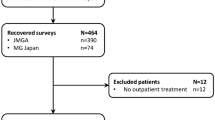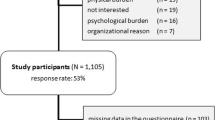Abstract
The aim of this study was to assess factors that might influence the health-related quality of life (HRQoL) in patients with myasthenia gravis (MG). A cross-sectional study was performed including 230 consecutive patients with MG. Severity of the disease was estimated according to the MGFA classification and QMG score. HRQoL was assessed by the SF-36 questionnaire. Depressive and anxiety symptoms were assessed using the Hamilton rating scales for depression and anxiety, respectively. Social support was measured by the Multidimensional Scale of Perceived Social Support (MSPSS), and acceptance of the disease by the Acceptance of Illness Scale. The significant demographic predictors of worse HRQoL in MG patients were older age (p = 0.025) and lower education (p = 0.012). Among clinical features, significant independent contributing factors of worse HRQoL were more severe form of the disease according to MGFA (p = 0.001) and higher QMG score (p = 0.001). Finally, psychosocial predictors of worse quality of life were lower MSPSS score (p = 0.001), poor acceptance of the disease (p = 0.001), as well as higher levels of anxiety and depression (p = 0.001). Our study revealed that the HRQoL in patients with MG is similarly reduced in its psychological and physical aspects. These results may have a practical implication pointing out that different aspects of psychosocial support should be added to the regular therapeutic protocols.


Similar content being viewed by others
References
Meriggioli M, Sanders D (2009) Autoimmune myasthenia gravis: emerging clinical and biological heterogeneity. Lancet Neurol 8:475–490
Padua L, Evoli A, Aprile I, Caliandro P, Mazza S, Padua R et al (2001) Health-related quality of life in patients with myasthenia gravis and the relationship between patient-oriented assessment and conventional measurements. Neurol Sci 22:363–369
Mullins L, Carpentier M, Paul R, Sanders D (2008) Disease-specific measure of quality of life for myasthenia gravis. Muscle Nerve 38:947–956
Paul RH, Nash JM, Cohen R, Gilchist J, Goldstein J (2001) Quality of life and well-being of patients with myasthenia gravis. Muscle Nerve 24:512–516
Leonardi M, Raggi A, Antozzi C, Confalonieri P, Maggi L, Cornelio F et al (2010) The relationship between health, disability and quality of life in myasthenia gravis: results from an Italian study. J Neurol 257:98–102
Raggi A, Leonardi M, Mantegazza R, Casale S, Fioravanti G (2009) Social support and self-efficacy in patients with myasthenia gravis: a common pathway towards positive health outcomes. Neurol Sci 31:41–45
Raggi A, Leonardi M, Antozzi C, Confaloineri P, Maggi L, Cornelio F et al (2010) Concordance between severity of disease, disability and health-related quality of life in myasthenia gravis. Neurol Sci 31:41–45
Drulovic J, Pekmezovic T, Matejic B, Mesaros S, Manigoda M, Dujmovic I et al (2007) Quality of life in patients with multiple sclerosis in Serbia. Acta Neurol Scand 115:147–152
Peric S, Rakocevic-Stojanovic V, Stevic Z, Basta I, Pavlovic S, Vujanac V et al (2010) Health-related quality of life in patients with myotonic dystropy type 1 and amyotrophic lateral sclerosis. Acta Neurol Belg 110:71–77
Rostedt A, Padua L, Stalberg E (2006) Validation of the Swedish version of the disease-specific Myasthenia Gravis Questionnaire. Neurol Sci 27:91–96
Rostedt A, Padua L, Stalberg EV (2006) Correlation between regional myasthenic weakness and mental aspects of quality of life. Eur J Neurol 13:191–193
Twork S, Wiesmeth S, Klewer J, Pohlau D, Kuglerg J (2010) Quality of life and life circumstances in German myasthenia gravis patients. Health Qual Life Outcomes 8:129
Winter Y, Schepelmann K, Spottke AE, Claus D, Grothe C, Schroder R et al (2010) Health-related quality of life in ALS, myasthenia gravis and facioscapulohumeral muscular dystrophy. J Neurol 257:1473–1481
Kulkantrakorn K, Sawanyawisuth K, Tiamkao S (2010) Factors correlating quality of life in patients with myasthenia gravis. Neurol Sci 31:571–573
Chen YT, Chang Y, Chiu HC, Yeh JH (2011) Psychosocial aspects in myasthenic patients treated by plasmapheresis. J Neurol 258:1240–1246
Lavrnic D, Jerebinski M, Rakocevic-Stojanovic V, Stevic Z, Lavrnic S, Pavlovic S et al (1999) Epidemiological and clinical characteristics of myasthenia gravis in Belgrade, Yugoslavia (1983–1992). Acta Neurol Scand 100:168–174
Lavrnic D, Losen M, Vujic A, De Baets M, Hajdukovic LJ, Stojanovic V et al (2005) The features of myasthenia gravis with autoantibodies to MuSK. J Neurol Neurosurg Psychiatry 76:1099–1102
Basta I, Pekmezovic T, Padua L, Stojanovic V, Stevic Z, Nikolic A et al (2010) Validation of Serbian version of the disease-specific Myasthenia Gravis Questionnaire. Acta Neurol Scand 122:110–114
Osserman KE, Genkins G (1971) Studies in myasthenia gravis: review of twenty-year experience in over 1200 patients. Mt Sinai J Med 38:497–537
Stalberg E (1980) Clinical electrophysiology in myasthenia gravis. J Neurol Neurosurg Psychiatry 43:622–633
Jeretzki A, Barohn RJ, Ernstoff RM, Kaminski HJ, Keesey JC, Penn AS et al (2000) Myasthenia gravis: recommendations for clinical research standards. Task Force of the Medical Scientific Advisory Board of the Myasthenia Gravis Foundation of America. Neurology 55:16–23
Barohn RJ, McIntire D, Herbelin L, Wolfe GI, Nations S, Bryan W (1998) Reliability testing of the Quantitative Myasthenia Gravis Score. Ann N Y Acad Sci 841:769–772
Hamilton M (1960) A rating scale for depression. J Neurol Neurosurg Psychiatry 23:56–62
Hamilton M (1959) The assessment of anxiety status by rating. Br J Med Psychol 32:50–55
Felton BJ, Revenson TA (1984) Coping with chronic illness: a study of illness controllability and influence of coping strategies on psychological adjustment. J Consult Clin Psychol 2:343–353
Zimet GD, Powell SS, Farley GK et al (1990) Psychometric characteristics of the MSPSS. J Pers Assess 55:610–617
http://www.qualitymetric.com SF-36 health survey (original version) language recalls. Accessed 01 Jan 2008
Ware JE, Sherbourne CD (1992) 36-Item Short-Form Health Survey (SF-36). Conceptual framework and item selection. Med Care 30:473–483
Kulaksizoglu IB (2007) Mood and anxiety disorders in patients with myasthenia gravis: aetiology, diagnosis and treatment. CNS Drugs 21:473–481
Pekmezovic T, Svetel M, Ivanovic N, Dragasevic N, Petrovic I, Kisic-Tepavcevic D et al (2009) Quality of life in patients with focal dystonia. Clin Neurol Neurosurg 111:161–164
Svetel M, Pekmezovic T, Tomic A, Kresojevic N, Potrebic A, Jesic R et al (2011) Quality of life in patients with treated and clinically stable Wilson’s disease. Mov Disord 26:1503–1508
Acknowledgments
This investigation was supported by the Ministry of Science of the Republic of Serbia (Grants No 175087 and 175083).
Author information
Authors and Affiliations
Corresponding author
Rights and permissions
About this article
Cite this article
Basta, I.Z., Pekmezović, T.D., Perić, S.Z. et al. Assessment of health-related quality of life in patients with myasthenia gravis in Belgrade (Serbia). Neurol Sci 33, 1375–1381 (2012). https://doi.org/10.1007/s10072-012-1170-2
Received:
Accepted:
Published:
Issue Date:
DOI: https://doi.org/10.1007/s10072-012-1170-2




